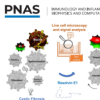 Group updates
Group updates
 Corrective role of resolvin E1 in ciliary dyskinesia in cystic fibrosis, a study published in PNAS by Valérie URBACH’s group, Sophie LANONE’s team. More info
Corrective role of resolvin E1 in ciliary dyskinesia in cystic fibrosis, a study published in PNAS by Valérie URBACH’s group, Sophie LANONE’s team. More info
 Congratulations to Khadeeja SY, PhD student in Sophie Lanone’s team and Valérie Urbach’s group, who wins the prize for best oral communication at the 24th Colloque des jeunes chercheurs organized by Vaincre La Mucoviscidose on February 7, 2023. More info
Congratulations to Khadeeja SY, PhD student in Sophie Lanone’s team and Valérie Urbach’s group, who wins the prize for best oral communication at the 24th Colloque des jeunes chercheurs organized by Vaincre La Mucoviscidose on February 7, 2023. More info
 Mucoviscidosis: why are women more vulnerable to the disease? Interview with Valérie Urbach in The Conversation, 20 minutes, and Fréquence Médicale. The Conversation du 24 janvier 2023 – 20 Minutes du 3 février 2023 – Fréquence Médicale du 2 février 2023
Mucoviscidosis: why are women more vulnerable to the disease? Interview with Valérie Urbach in The Conversation, 20 minutes, and Fréquence Médicale. The Conversation du 24 janvier 2023 – 20 Minutes du 3 février 2023 – Fréquence Médicale du 2 février 2023
 Video by Valérie Urbach for the Virades de l’Espoir 2023 organized by the patient association Vaincre La Mucoviscidose. More info
Video by Valérie Urbach for the Virades de l’Espoir 2023 organized by the patient association Vaincre La Mucoviscidose. More info
 Congratulations to Maëlle BRIOTTET, doctoral student in Sophie Lanone’s team in Valérie Urbach’s group, who received the Prize of the association Vaincre la Mucoviscidose during the French Symposium for Young Researchers. More info
Congratulations to Maëlle BRIOTTET, doctoral student in Sophie Lanone’s team in Valérie Urbach’s group, who received the Prize of the association Vaincre la Mucoviscidose during the French Symposium for Young Researchers. More info
 Research focus:
Research focus:
The inflammatory response is a protective mechanism but its persistence results in tissue damage. Thus, this process is normally autoregulated by an active resolution phase which requires specialized pro-resolving lipid mediators (SPM) such as lipoxins, resolvins, protectins and maresins. SPMs limit the infiltration of neutrophils and stimulate their clearance; they improve phagocytosis and the elimination of bacteria and are also involved in adaptive immunity with the regulation of T and B lymphocytes. Thus, abnormalities in the biosynthesis or function of SPMs would play a major role in chronic inflammatory diseases.
We have begun to describe the cellular and molecular mechanisms of action of SPMs in the airways as well as the processes involved in the abnormalities of their biosynthesis in cystic fibrosis (Chiron, 2008; Grumbach et al, 2009; Verriere et al, 2012; Buchanan et al 2013; Higgins et al, 2014; Al-Alawi et al, 2014;, Higgins et al, 2014; Ringholz et al, 2014; Jeanson et al, 2014; Higgins et al, 2016, Ringholz et al, 2018; Shum et al, 2021, Briottet et al, 2024). The possible roles of SPMs in other respiratory pathologies are not elucidated.
Our general objectives are therefore to characterize the abnormalities in the regulation of innate immunity and their resolution in airway chronic inflammatory conditions (cystic fibrosis, primary cilia dyskinesia (PCD), exposure to air pollution, etc.) using biological samples from patients (primary nasal epithelium cultures, nasal secretions, sputum, Aspergillus fumigatus, etc.). Our translational research activity is based on collaborations between scientists and clinicians from the GEI2CO team and the site (Faculty of Health of UPEC, Mondor Hospital, Center Hospitalier Intercommunal de Créteil), with the support of the association of patients with Cystic Fibrosis (Vaincre la mucoviscidose) and ANR. Our work is structured around the following axes:
- Role of SPMs in the regulation of airway epithelial functions associated with innate immunity (inflammatory response, polarization, antimicrobial peptides, ciliary beating, mucus rheology, epithelial repair) in cystic fibrosis.
- Cellular and molecular mechanisms involved in SPM biosynthesis abnormalities, and particularly the role of sex for patients with cystic fibrosis.
- Regulation of inflammation and bronchial obstruction in other chronic inflammatory diseases of the airways and in particular primary ciliary dyskinesia.
 Main results:
Main results:
- Ciliary dyskinesia (↘ frequency and quantity of movement, ↗ synchronization and orientation), airway surface liquid and mucus abnormalities observed in cystic fibrosis are corrected by the resolvin E1 and lipoxin B4 (Briottet et al, 2024, DOI: 1073/pnas.2313089121)).
- Airway epithelial cells derived from patients with cystic fibrosis have a reduced capacity to produce specialized pro-resolving lipid mediators. This phenomenon is worsened for women with cystic fibrosis (Shum et al, 2022, DOI: 10.3389/fimmu.2022.915261) (Urbach et al, 2023).
- Airway epithelial cells derived from CF patients and even more in females have reduced abilities to produce SPMs. The SPMs LXA4, LXB4, RvD2, RvD5, PD1 and RvE3 are reduced in CF samples (compared to non-CF) and the RvD3, RvD4, and PD1 are reduced in samples from CF females (compared to non-CF). These data are consistent with a contribution of CF airway epithelium in the abnormal resolution of inflammation and with the worse pulmonary outcomes in women (Shum et al, 2022).
- Resolvin D1 regulates epithelial ion transport, cytokine production and macrophage activity in models (in vitro and in vivo) of CF airways (Ringholz et al, 2018).
- Lipoxin A4 delays the colonization of CF bronchial epithelial cells by Pseudomonas aeruginosa (Higgins et al, 2016).
- Lipoxin A4 restores airway surface liquid layer height in CF airway epithelial cells by stimulating a calcium-activated chloride secretion and inhibiting sodium absorption (Verriere et al, 2012, Higgins et al, 2014, Al-Alawi et al, 2014).
- Lipoxin A4 protects CF airway epithelial structure by stimulating wound healing and tight junction formation (Grumbach et al, 2009, Buchanan et al 2013, Higgins et al, 2014).
- The 15-lipoxygenase 2 and lipoxin A4 / leukotriene B4 ratio are reduced in bronco-alveolar lavage fluid of children with CF (Ringholz et al, 2014).
- The 15-lipoxygenase expression is reduced in nasal polyps from CF patients compared to non-CF subjects (Jeanson et al, 2014).
- Lipoxin A4 level increases while interleukin-8 decreased in CF sputum after antibiotic therapy and correlated with an improved lung function (Chiron, 2008).